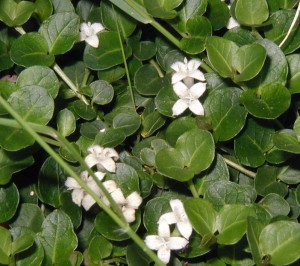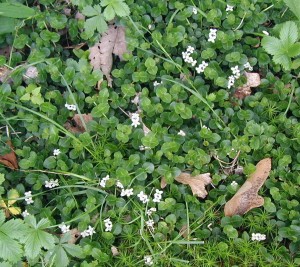Partridgeberry, Mitchella repens, is a member of the Madder Family, Rubiaceae. It’s one of the plants that just make me think, “Forest Flowers.” You won’t find it growing anywhere else but in a forest or perhaps in a shade garden. Partridgeberry is native to the Eastern North America.
The terminal white or pink trumpet-like flowers are fragrant. The four petals are fuzzy-looking due to hairs on the inside of the petals. Twin flowers seem to be connected at their bases by a common stipule.

Stems are creeping with small, opposite, leathery, round evergreen leaves. Leaves usually have a light-colored midrib and sometimes the other leaf veins stand out with a lighter color. Leaves are otherwise dark green and entire, or untoothed.


Twin flowers coalesce into a single red berry that may last through winter and remain at the tip of the vine until Spring. Peterson’s Edible Plant Guide tells us the berry is edible – it just doesn’t taste like anything. The tasteless berries can be used as a survival food or added to salads for a bit of color.
Partridgeberry does seem to have medicinal properties. A leaf or berry tea was used historically for treating female problems, such as irregular or painful periods and childbirth pain, which lent partridgeberry the nickname Squaw Vine. Astringent qualities of the tea led to its external use for skin irritations and as a wash to soothe arthritis.
